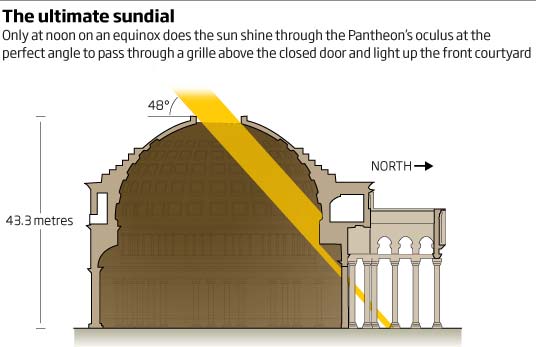Is the Roman Pantheon a colossal sundial?
Has the grand Roman Pantheon been keeping a secret for nearly 2000 years? An expert in ancient timekeeping thinks so, arguing that it acts as a colossal sundial.
Is the Roman Pantheon a colossal sundial?
04 February 2009 by Jo Marchant
Has the grand Roman Pantheon been keeping a secret for nearly 2000 years? An expert in ancient timekeeping thinks so, arguing that it acts as a colossal sundial.
The imposing temple in Rome, completed in AD 128, is one of the most impressive buildings that survives from antiquity. It consists of a cylindrical chamber topped by a domed roof with an oculus in the top which lets through a dramatic shaft of sunlight. It boasts a colonnaded courtyard at the front.
When Robert Hannah of the University of Otago in Dunedin, New Zealand, visited the Pantheon in 2005, researching for a book (see “Review: Time in Antiquity by Robert Hannah”), he realised that the Pantheon may have been more than just a temple. During the six months of winter, the light of the noon sun traces a path across the inside of the domed roof. During summer, with the sun higher in the sky, the shaft shines onto the lower walls and floor. At the two equinoxes, in March and September, the sunlight coming in through the hole strikes the junction between the roof and wall, above the Pantheon’s grand northern doorway (see diagram). A grille above the door allows a sliver of light through to the front courtyard – the only moment in the year that it sees sunlight if its main doors are closed (see diagram).
Hannah reckons this is no coincidence. A hollowed-out hemisphere with a hole in the top was a type of sundial used in Roman times, albeit on a much smaller scale, to show the time of year. While the Pantheon’s dome is quite flat on the outside, it forms a perfect hemisphere inside. “This is quite a deliberate design feature,” says Hannah.
Pantheon means “all of the gods” and the building’s roof represented the dome of the sky, where Romans believed the gods resided. At equinox, the sun is on the celestial equator – where Earth’s equator would lie if projected into space – which was seen as the most stable part of the sky, a perfect eternal home for the gods. Hannah thinks that by marking the equinoxes, the Pantheon was intended to elevate emperors who worshipped there into the realm of the gods.
James Evans, a historian of astronomy at the University of Puget Sound in Washington state, is intrigued: “The architect of the Pantheon would certainly have been aware of the symbolic connections between the cosmos and the empire, and between the sun and the emperor.” He doesn’t believe the case is proven, however, as no markings survive in the Pantheon that relate to a sundial.
Hannah counters that sundials rarely came with instructions: “They were part of the culture, they wouldn’t need to explain themselves.”
Source: Issue 2693 of New Scientist magazine
1,350 views
Tags: Pantheon, Rome, sundial, temple
This entry was posted on Friday, May 17th, 2024 at 9:05 pm and is filed under Articles.
You can follow any responses to this entry through the RSS 2.0 feed.
You can leave a response, or trackback from your own site.




















